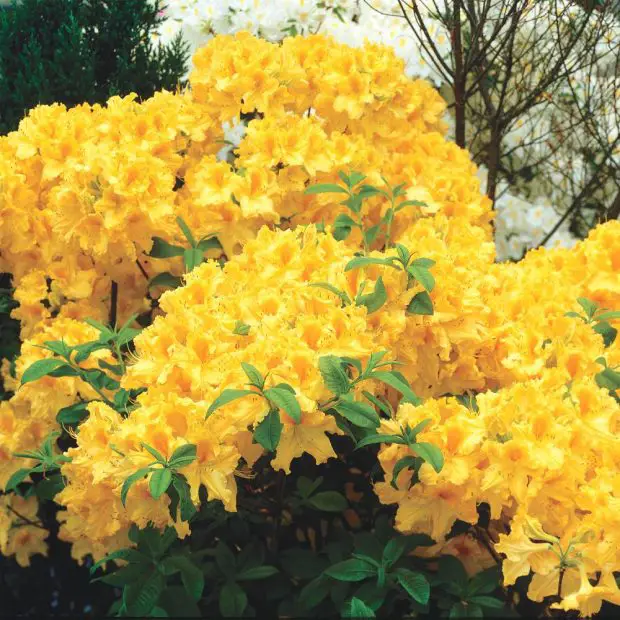Azaleas bring vibrant color and timeless elegance to gardens, but knowing exactly when to prune them can make all the difference between a full, blooming shrub and a disappointing display. With their delicate growth cycle and bloom-on-old-wood habit, azaleas require careful timing and technique to thrive year after year.
In this seasonal guide, you’ll discover the best time to prune azaleas, how different varieties respond to trimming, and expert advice to help your plants stay healthy, well-shaped, and full of blossoms. Whether you’re growing evergreen or deciduous azaleas, the right pruning strategy will keep your garden glowing with beauty.
Understanding the Growth Cycle of Azaleas

Understanding the growth cycle of azaleas is key to pruning them correctly and ensuring consistent blooms each year. Most azaleas bloom on old wood, meaning the flower buds for spring form during the summer and fall of the previous year. Once these buds open in spring, the plant enters a period of active growth, producing new stems and leaves throughout the summer.
This new growth will then set the stage for next year’s flowers. If you prune too late in the season—after the buds have already begun forming—you risk cutting them off and reducing the next bloom cycle. By learning this cycle, gardeners can time their pruning to encourage healthy development without disrupting the plant’s natural rhythm. Recognizing when azaleas transition from flowering to vegetative growth is essential for maximizing both shape and floral display.
The Best Time of Year to Prune Azaleas
The best time of year to prune azaleas is right after they finish blooming in spring, typically from late April to early June, depending on your climate and the specific azalea variety. This post-bloom period is ideal because it allows you to remove spent flowers, shape the shrub, and encourage new growth—all without interfering with next season’s flower buds.
Azaleas bloom on old wood, which means the buds for next year begin forming not long after the current flowers fade. If you prune too early, you’ll cut off the blooms you waited all year to see. If you prune too late—especially after midsummer—you risk trimming away developing buds for next spring’s display, leaving you with a less colorful garden.
By pruning during this narrow window, you give your azaleas time to recover and grow vigorously through the summer. New branches formed during this period will have the rest of the growing season to mature and set buds. For the best results, avoid pruning in late summer or fall, when the plant is preparing for dormancy and should not be stressed. Proper timing ensures healthier growth, a well-shaped plant, and a spectacular bloom cycle year after year.
Pruning Based on Azalea Varieties
Pruning needs can vary depending on the type of azalea you’re growing, as different varieties have distinct growth habits and blooming times. Evergreen azaleas, which keep their leaves year-round, typically bloom in spring and respond well to light pruning right after flowering. These varieties, such as Kurume and Southern Indica azaleas, benefit from gentle shaping each year to maintain a compact, tidy form.
Deciduous azaleas, on the other hand, lose their leaves in fall and often have a more open, upright growth habit. They may bloom slightly later than evergreen types and can tolerate more aggressive pruning, especially if you’re rejuvenating an overgrown plant. With deciduous varieties, it’s still important to prune after blooming, but you can cut back older stems more heavily to encourage new shoots and stronger structure.
For reblooming azaleas, like the popular Encore series, timing becomes even more crucial. These plants flower in both spring and late summer or early fall, so pruning should be done immediately after the first bloom cycle. This allows enough time for new buds to form for the second flush of flowers. In all cases, understanding your azalea’s variety ensures that pruning enhances—not hinders—its natural blooming cycle and overall appearance.
Signs Your Azalea Needs Pruning
Knowing when your azalea needs pruning helps maintain its health, shape, and bloom potential. One of the clearest signs is leggy growth, where the shrub becomes tall and sparse with fewer leaves or flowers near the base. This indicates it’s time to prune back to encourage fuller, bushier growth.
Another common sign is fewer or smaller blooms than in previous seasons. This can happen when the plant becomes overcrowded, with too many old branches competing for nutrients and sunlight. Light thinning can reinvigorate blooming by allowing more airflow and light penetration.
You might also notice dead, damaged, or diseased branches, especially after a harsh winter or periods of drought. Removing these helps the plant direct its energy toward healthy new growth and prevents the spread of disease.
Lastly, uneven or misshapen growth can signal that your azalea needs shaping. If one side is growing faster or taller than the rest, a light trim can restore symmetry and improve the plant’s overall appearance. Regularly observing your azalea and responding to these signs ensures a vibrant, healthy shrub year after year.
Tools You’ll Need for Pruning Azaleas
Having the right tools on hand makes pruning azaleas easier, safer, and more effective. Using clean, sharp, and appropriate equipment not only ensures precise cuts but also reduces the risk of damaging the plant or spreading disease.
The most essential tool is a pair of sharp hand pruners or secateurs. These are ideal for cutting branches up to ½ inch thick and allow for controlled, clean cuts on new growth or crossing stems. For thicker, older branches, you’ll need loppers, which have longer handles and provide better leverage to handle woody stems without crushing them.
A pruning saw is useful for removing large or dead limbs, especially on older azaleas. Choose a fine-toothed saw for smooth cuts that heal quickly.
Gloves are also important to protect your hands from scratches and irritants, especially if your azaleas are located in dense or overgrown areas.
To prevent disease transmission between cuts or plants, always sanitize your tools before and after pruning. Use rubbing alcohol (at least 70%), a 10% bleach solution, or commercial disinfectant sprays. This is especially critical when removing dead or diseased wood.
For shaping and light touch-ups, hedge shears can be used carefully, but they should never replace hand tools when it comes to detailed pruning, as they can leave uneven or ragged cuts.
Keeping your tools sharp and well-maintained is just as important as choosing the right ones. Dull blades can crush stems and slow healing, leading to potential entry points for disease.
By preparing with the proper tools and maintaining them well, you’ll make the pruning process smoother and ensure your azaleas respond with healthy, vigorous growth.
Techniques for Effective Azalea Pruning
Effective azalea pruning requires a combination of proper timing, the right tools, and thoughtful technique to enhance plant health and encourage better blooms. Start by using clean, sharp pruning shears to make precise cuts that minimize damage and reduce the risk of disease. Always disinfect your tools before and after pruning to prevent the spread of pathogens.
Begin with removing any dead, damaged, or diseased wood, cutting back to a healthy section of the stem or branch collar. This not only improves appearance but also supports new, vigorous growth. Next, thin out crowded or crossing branches, especially in the interior of the shrub, to improve air circulation and sunlight exposure—both of which help reduce pest and fungal problems.
For shaping, focus on light trimming just after blooming, cutting above leaf nodes to guide growth in your desired direction. Avoid cutting too far back into bare wood, as azaleas don’t always regenerate from old, woody stems. If rejuvenation is needed for an older or overgrown shrub, consider cutting one-third of the oldest stems down to near ground level each year over a three-year cycle to slowly refresh the plant without shocking it.
Lastly, always step back and assess the shrub’s overall shape as you prune. Aim for a natural, airy form that suits the plant’s growth habit rather than a rigid, manicured look. Proper technique ensures your azalea stays healthy, beautiful, and bursting with blooms each season.
Differences Between Pruning Evergreen and Deciduous Azaleas
Understanding whether your azaleas are evergreen or deciduous is key to pruning them correctly and ensuring long-term health and vibrant blooms.
Evergreen azaleas, as the name suggests, retain their leaves year-round and are more commonly grown in temperate and subtropical climates. These types typically bloom in spring on old wood, so the best time to prune is immediately after flowering, usually in late spring to early summer. Pruning too late in the season risks removing buds that have already started forming for next year. Evergreen azaleas benefit from light shaping and thinning to maintain airflow and form, but they should never be heavily cut back into old, leafless wood, as they may not regenerate from those points.
Deciduous azaleas, on the other hand, lose their leaves in fall and go dormant in winter. These varieties often have a more open, upright growth habit and may bloom slightly later depending on the species. Because of their dormancy, you can prune deciduous azaleas during late winter or very early spring, just before new growth begins. This timing allows you to shape the plant without interfering with bud development. Deciduous types are generally more tolerant of heavier pruning, including rejuvenation cuts, which makes them easier to manage if they’ve become overgrown.
Additionally, deciduous azaleas may require less frequent maintenance pruning, while evergreen types often need yearly touch-ups to stay tidy and floriferous. Being aware of these differences helps you tailor your pruning routine to match each plant’s natural rhythm—maximizing blooms and minimizing stress.
Tips for Post-Pruning Care
After pruning your azalea, providing the right post-pruning care is essential to help the plant recover and encourage healthy, vigorous growth. Start by watering thoroughly, especially if conditions are dry. Pruning stimulates new shoot development, which increases the plant’s water needs. Keep the soil consistently moist but not soggy for the next few weeks to support recovery.
Mulching is another key step—apply a 2–3 inch layer of organic mulch, such as pine bark or shredded leaves, around the base of the shrub. This helps conserve moisture, regulate soil temperature, and suppress weeds. Be sure to keep mulch a few inches away from the trunk to prevent rot.
Avoid fertilizing immediately after heavy pruning, as this can stress the plant. Wait a few weeks, then apply a balanced, slow-release fertilizer designed for acid-loving plants if growth appears sluggish or leaves begin to pale.
Keep an eye out for pests or diseases in the weeks following pruning. Open cuts can temporarily make the plant more vulnerable, so early detection and treatment are important.
Finally, monitor your azalea for signs of new growth. Healthy response typically appears within a few weeks as fresh shoots emerge. With proper post-pruning care, your azalea will bounce back quickly, forming a well-shaped shrub and setting the stage for stunning future blooms.
Common Mistakes to Avoid When Pruning Azaleas
Pruning azaleas might seem straightforward, but several common mistakes can hinder blooming and compromise plant health if not avoided.
One of the biggest errors is pruning at the wrong time. Azaleas bloom on old wood, so pruning too late—especially in summer or fall—can remove next season’s flower buds. The ideal time is right after the plant finishes blooming in spring, giving it enough time to set buds for the following year.
Another frequent mistake is over-pruning, where too much of the plant is cut back at once. Azaleas do not respond well to severe cuts, especially into bare wood where there are no visible leaves or buds. Unlike some shrubs, they may not regrow from old stems, resulting in bare patches or permanent damage.
Ignoring the plant’s natural shape is also a concern. Azaleas look best with a soft, flowing form. Harsh shearing or shaping them into tight, artificial forms can ruin their appearance and reduce airflow, leading to fungal problems.
Many gardeners also forget to remove dead or diseased wood first, which is essential for plant health. Pruning without cleaning tools can spread diseases between cuts or plants—always disinfect your shears before and after use.
Lastly, neglecting post-pruning care, such as watering or mulching, can delay recovery. Even a properly pruned azalea needs support to bounce back and continue developing healthy foliage and buds.
Avoiding these mistakes ensures your azalea remains lush, balanced, and full of brilliant blooms year after year.
Encouraging Re-Blooming After Pruning
While most traditional azaleas bloom once a year in spring, some modern varieties—especially reblooming cultivars like the Encore, Bloom-A-Thon, or ReBLOOM series—can flower multiple times with the right care. Proper pruning plays a crucial role in encouraging these secondary or extended bloom cycles.
To promote re-blooming, it’s essential to prune at the right time. For single-season bloomers, prune just after the spring flowers fade to give the plant time to set buds for next year. For reblooming varieties, a light pruning after each bloom cycle—typically in late spring and again in mid- to late summer—can stimulate fresh growth and another wave of flowers.
Avoid heavy pruning after midsummer, especially in cooler climates, as this may cut off developing buds for the fall or the next spring. Instead, focus on selective trimming of spent flowers and leggy stems to redirect the plant’s energy into new growth.
In addition to timing, good cultural care is vital. After pruning, give your azalea a light dose of balanced fertilizer (such as 10-10-10 or 12-6-6) to support healthy regrowth. Ensure consistent watering, especially during dry spells, as drought stress can suppress blooming.
Finally, make sure your azalea receives adequate light—ideally dappled sun or morning sun with afternoon shade. Insufficient light is a common reason why azaleas don’t rebloom, even if pruned correctly.
By combining strategic pruning with proper aftercare, you can extend the blooming season and enjoy vibrant azalea flowers well beyond spring.
Frequently Asked Questions About Prune Azalea
When is the best time to prune azaleas without affecting next season’s blooms?
The best time to prune azaleas is right after they finish blooming in spring—typically between late spring and early summer, depending on your region. Azaleas begin forming buds for the next year’s flowers shortly after blooming ends. If you prune too late, especially beyond mid-summer, you risk cutting off these developing buds, which means fewer or no flowers the following spring. By pruning right after the bloom cycle, you give the plant plenty of time to grow new shoots and set flower buds before fall.
How much of the azalea can I prune at once?
Azaleas respond best to light and gradual pruning. As a general rule, never remove more than one-third of the plant in a single session. Over-pruning, especially into bare, woody stems that lack leaves or visible buds, may result in poor regrowth or plant shock. Instead, focus on removing dead, diseased, or crossing branches, lightly shaping the canopy, and thinning out overly dense interior stems to improve air circulation. If your azalea is overgrown, consider rejuvenation pruning gradually over two to three years.
Do evergreen and deciduous azaleas require different pruning techniques?
Yes, pruning should be tailored to the type of azalea. Evergreen azaleas, which retain their leaves year-round, benefit from light pruning immediately after flowering. These types don’t respond well to hard cuts, especially into leafless wood. Light shaping and selective thinning are usually all that’s needed. Deciduous azaleas, which lose their leaves in winter, are more tolerant of heavier pruning. They can be pruned in late winter or very early spring before new growth emerges. For both types, avoid pruning after mid-summer to prevent bud loss.
What tools should I use to prune azaleas?
To prune azaleas effectively and safely, you’ll need a few essential tools:
Bypass pruners for clean cuts on thin branches
Loppers for thicker, woody stems that are harder to cut
Gloves to protect your hands from thorns or rough branches
Rubbing alcohol or disinfectant to sterilize your tools before and after pruning to prevent the spread of disease
Make sure all blades are sharp and clean, as dull tools can crush stems, causing damage and opening the plant to infection.
Can pruning encourage azaleas to bloom more than once a year?
Yes, but this mostly applies to reblooming azalea varieties, such as Encore, Bloom-A-Thon, or Rebloom. These cultivars are specially bred to flower in spring and again later in the season, usually late summer or early fall. Light pruning after the first bloom—just enough to remove spent flowers and shape the plant—can encourage new growth and a second round of flowering. For best results, pair pruning with proper care: consistent watering, light fertilization, and enough sunlight (morning sun is ideal). Regular deadheading also helps conserve the plant’s energy for more blooms.
Conclusion: Prune with Purpose and Timing
Knowing when to prune azaleas makes a significant difference in their health and flowering potential. By pruning just after blooming, using gentle techniques, and tailoring your approach to the specific variety, you can maintain a beautifully shaped shrub that bursts into bloom year after year. Whether you’re tending a compact evergreen azalea or a sprawling deciduous variety, proper timing ensures your garden enjoys the full beauty these plants have to offer.






